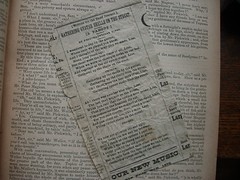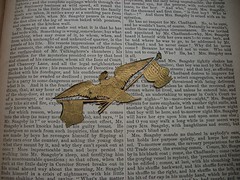About a year ago I bought several books in an old set of Dickens' collected works from a book store that was going out of business. I bought them initially because of the nice texture that 19th century books have, but after reading Susanna Clarke's excellent Jonathan Strange & Mr. Norrell while doing "research" about magic, I decided to go back to read some of the Dickens that was her inspiration. I'm currently reading Bleak House, and apart from being kind of an amusing experience typographically (the letter spacing is definitely different than today's books and the books are slightly oversize and printed in small, two-column type to minimize paper cost, and I find I actually like the form factor), it's an interesting experience because the book keeps yielding pieces of its history in a way that modern artifacts rarely do. Here are some clues:
The inscription in the front has an oddly defensive quality, but is written with full names as a kind of explicit "message in a bottle" to future purchasers, to show that there were real people who really owned this book and that parting with it was not a wholly easy process:
Then there was this piece of music, which was either being used as a bookmark or just kept in the book for safekeeping. It also gives a good date for when the last time the book was read, which was likely the first time it was read, 1879:
Finally, this fell out this morning. I believe it's a souvenir of the US Centennial:
Apart from the amusing way to date the publication of the book (which is not rare in any way--I checked on Ebay) to the mid-late 1870s, these artifacts reminded me of the personalization traditional artifacts exhibit that today's digital artifacts do not. You can't stick a newspaper clipping into a Kindle and forget about it (though, admittedly, "time capsule" is a tertiary purpose for a book, too) and it would be weird to inscribing a mobile phone with its owners' history. Yet that's regularly found on furniture, in books, and even in older clothes. It gives these objects a depth that's meaningful in ways that transcend functionality, esthetics or design. There was an old SNL sketch about a Sentimental Pawn Shop which parodies the fact that sentiment and history have no material value. Th pieces of the original owners' lives that have fallen out of these books actually brings back some of that value, not in monetary terms, but in the experience of ownership. I'm keeping all of the things I found in the books in the books and wondering how I can design digital artifacts that will exhibit some of the same qualities.






